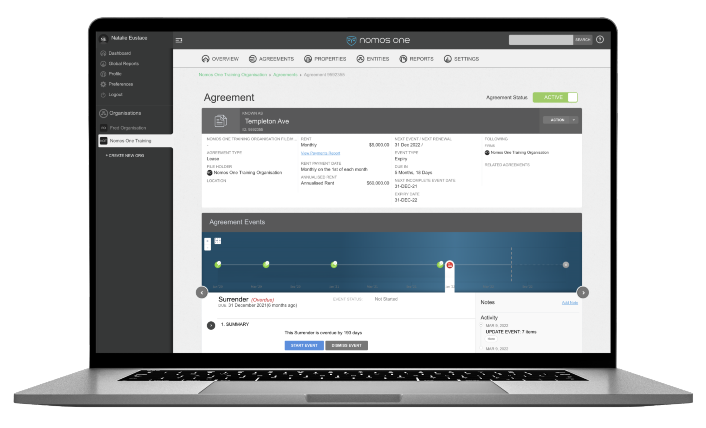Thinking of leases in the aviation sector, aircraft are typically the first thing that comes to mind, and understandably so - aircraft leasing is one of the most capital-intensive and strategically vital components of the industry. However, in aviation, leasing extends well beyond runways and flight decks. From terminal spaces and hangars to ground equipment and rights-of-use agreements, the modern aviation lease portfolio is broad, complex, and spans multiple operational areas.
Despite this reality, many lease management tools remain narrowly focused, often designed with only aircraft leasing in mind. This poses serious limitations for aviation companies that must manage a full spectrum of lease types under one organisational roof. A disjointed approach to managing these leases results in disconnected systems, inconsistent processes, and significant gaps in compliance and oversight. In this article, we examine why a holistic approach to lease management is critical for aviation businesses, explore the challenges of managing varied lease types, and show how dedicated software like Nomos One helps bring clarity and control to even the most complex lease portfolios.

The complex nature of aviation leasing
While aircraft leases account for a significant portion of aviation businesses' financial obligations, they are far from the only leases that matter. In practice, aviation companies operate within a highly leased environment where access to physical space, infrastructure, and equipment is often governed by long-term, high-value contracts. Terminal-side leases, for example, cover everything from airline check-in counters and lounges to boarding gates and baggage handling areas. Hangars and maintenance facilities are often leased under bespoke agreements that include service provisions and compliance clauses. Ground service equipment, such as tow vehicles, mobile stairs, and cargo loaders, are frequently leased, maintained, and operated under its own set of conditions. In addition, many aviation businesses hold leases or licenses for administrative offices, fuel storage sites, rights-of-use over land, and even airspace-related infrastructure. Each of these lease types carries its own lifecycle, financial structure, renewal conditions, and reporting requirements. Managing this diversity requires more than spreadsheets or point solutions; it calls for a flexible system that can accommodate the full scope of lease activity in a way that is both operationally effective and IFRS 16 compliant.
Managing a diverse lease portfolio
The greatest challenge in holistic aviation lease management lies in the sheer diversity of assets and agreement types. Each lease may involve different payment intervals, escalation clauses, indexation methods, or termination conditions. Terminal leases might require annual adjustments based on passenger volume. Hangar agreements could involve co-use arrangements or long-term capital improvement plans. Ground equipment leases may be bundled with service contracts or governed by third-party ownership.
Bringing this all together under one system can be daunting. Without the right tools and oversight, lease data is often siloed between departments, deadlines are missed, key clauses are overlooked, and reporting becomes inconsistent across asset classes. This not only increases the risk of compliance breaches, especially under IFRS 16, but also undermines operational agility and financial visibility. For aviation businesses aiming to stay audit-ready, reduce risk, and align lease decisions with strategic goals, a unified system that supports all lease types is essential.

Importance of flexibility in lease management tools
A platform that can only accommodate one lease type or assumes every lease follows the same structure might not work well for aviation businesses. What’s needed is flexibility: aviation lease management tools must be capable of capturing detailed, lease-specific data points, adapting to different asset classes, and generating reliable reports across them all. Custom fields are vital for tracking unique data such as fuel throughput, floor area, maintenance cycles, or passenger traffic. A robust document repository ensures that all agreements, amendments, drawings, correspondence, and compliance materials are stored in one central location. Automated reminders for renewal windows, CPI adjustments, or maintenance milestones help teams avoid costly oversights. When it comes to reporting, data should allow stakeholders to slice data by region, asset type, department, or cost centre to support better decision-making. Nomos One is designed with this level of flexibility in mind, enabling aviation businesses to configure the platform to suit their specific needs, no matter how diverse their lease portfolio may be.
Supporting the full aviation lease lifecycle
Nomos One brings together every component of lease management under one secure, cloud-based system. Whether it is tracking an aircraft lease, a hangar agreement, or a rights-of-use contract, the platform provides the tools to manage each asset type with the same level of detail and consistency. Customisable fields allow users to tailor records based on asset type and lease conditions. Automated workflows and notifications keep teams on top of renewal periods, CPI increases, and contract obligations. The built-in IFRS 16 engine automatically calculates right-of-use assets, lease liabilities, depreciation, and interest expenses across all relevant lease agreements, whether they’re tied to a fleet or a fixed facility. Because Nomos One is cloud-based, it supports collaboration across departments and geographies. Teams can securely access lease information in real-time, track changes, and ensure everyone is working from the same data source, eliminating silos and streamlining communication between finance, operations, and legal.

In an industry that relies on infrastructure, mobility, and compliance, managing leases holistically is a strategic necessity. Whether you’re coordinating the renewal of terminal-side agreements or ensuring the accuracy of IFRS 16 disclosures across a multi-asset portfolio, having the right system in place can make all the difference. Nomos One empowers aviation businesses to take control of every lease, streamline workflows, reduce risk, and elevate lease accounting from a compliance burden to a strategic advantage. Learn how to manage all your aviation leases in one platform - book a demo now!

























